Health Care > EXAM > Patho NR 283 exam 1 ( Review 2022 with complete solution) (All)
Patho NR 283 exam 1 ( Review 2022 with complete solution)
Document Content and Description Below
In regards to chromosomal mutation, nondisjunction is known as what? - ANSWER Failure of homologous chromosomes to separate during cell division What is an example of an autosomal-dominant disease?... - ANSWER Huntington's disease What is an example of an autosomal-recessive disease? - ANSWER Cystic fibrosis What is an example of an X-linked condition? - ANSWER Red - green color blindness What is an example of multifactorial inheritance? - ANSWER Pyloric stenosis Knowing physiologic signs of injury you might expect the following system is consistent with systemic manifestations of cellular injury during a myocardial infarction (select all that apply) A. Elevated aspartate aminotransferase (AST/SGOT) C. Increased leukocytes D. Pain E. Increase heart rate F. Fever G. Elevated Creatinine Kinase H. Elevated alanin aminostransferase (ALT/SGPT) - ANSWER A. elevated aspartate aminotransferase C. increased leukocytes E. increased HR G. elevated creatinine kinase H. elevated alanin aminostransferase The nurse teaching an elderly client about the aging process includes which changes that occur as part of the normal aging process? (select all that apply) A. Increase in total body potassium concentration B. Increased gastric emptying C. Decreased muscle tone D. Wrinkling and atrophy of the epidermis E. Increase in peripheral resistance to blood flow F. Increased formation of autoantibodies - ANSWER A. Decreased muscle tone, wrinkling in atrophy of the epidermis E. increase in peripheral resistance to bloodflow F. increased formation of auto antibodies What else is it about the skin that protects individuals from injury and disease? - ANSWER Pathogens can be sloughed off by mechanical means, such as falling off in dead skin cells, coughing or sneezing, vomiting, or flushing from the urinary tract in urine. How might the characteristics of skin and the bodily fluids associated with it also help to protect us from infection? - ANSWER There is a low pH on the skin and stomach that generally inhibits microorganisms If inflammation is considered a first responder and may be considered to be a hero, at least when it is in a controlled state, what heroic acts may be attributed to it? How might the swelling associated with inflammation actually help with the healing process? Erythema and warmth at a site of injury typically cause discomfort, but how might one take solace in the fact that the response is being initiated? - ANSWER It prevents and/or limits infection and additional damage by initiating the influx of plasma, plasma proteins, plasma enzymes, and the distribution of leukocytes from the blood vessels to the injury. It recruits members of the adaptive immunity community to launch a more specific defense against the pathogens and enhances the healing process. What causes redness at the site of inflammation? - ANSWER Vasodilation of arterioles from the histamine triggered by mediators or mast cells but then spasm to stop the bleeding What is brought to the injured site when the vasodilation occurs? - ANSWER Neutrophils, monocytes, oxygen, nutrients to dilute toxins With vasodilation that dilates the capillaries, what lines the vessels? - ANSWER Leukocytes How do the traveling leukocytes (neutrophils and monocytes) arrive at the tissue where the site of the infection is present? - ANSWER The cell squeeze through the gaps in the capillary walls to enter at the site of the infection What does phagocytosis do at the site? - ANSWER Digests the foreign substances cellular debris Why is fibrinogen important at the site of injury? - ANSWER Fibrinogen transforms into fibrin to wall off the injured area, taking the foreign substances to make a mesh to support blood clotting and healing When the injury occurs, what stimulates the pain receptors? - ANSWER Prostaglandins Why does the hypothalamus increase the body temperature? - ANSWER Pyrogens are released by macrophages when exposed to bacteria What reaction in the body inhibits bacterial growth and causes the liver and spleen to remove iron in the body that some bacteria use for growth? - ANSWER fever What do cells release when they are attacked by viruses? - ANSWER inferferons Where do interferons travel to and why? - ANSWER They spread the infected cells to trigger the making of enzymes that would inhibit the viral replication What system with about 20 blood plasma proteins gets activated to attack the bacteria, causing it to let water into the bacteria's cell to swell, burst, and die? - ANSWER the complement system What is the process called that starts with vasodilation; increases permeability of vessels for the WBCs, macrophages, and plasma to go to the foreign cells; and forms a coat around the microbe to kill them? - ANSWER phagocytosis Interleukin six is produced primarily by which type of cell? A. Macrophages, lymphocytes, and fibroblasts B. Macrophages - ANSWER A. Macrophages, lymphocytes, and fibroblasts Which are the most predominate proinflammatory factors? A. interleukins B. RBC C. WBS - ANSWER A. interleukins In regards to wound healing, what is primary union? - ANSWER Wound edges can be matched together with serum and regeneration of tissue and connecting capillaries, fibroblasts, and laying of collagen that pulls the sides together when they shrink. There is typically very little tissue loss (e.g., surgical skin incision). In regards to wound healing, what is secondary union? - ANSWER It is a greater area of tissue loss and more inflammation. Greater amounts of tissue replacement, scar formation, and wound contraction result in a more lengthy healing process (e.g., late stage pressure ulcer). A client receiving an influenza vaccine (flu shot) asks when the immunization will be effective. The nurse response based on the knowledge that after receiving the vaccine, the levels of immunoglobulin M (IgM) are high enough to provide immunization (select all that apply) A. in 7 days B. after 24 hours C. in 10 days D. in 48 hours E. in 14 days F. immediately - ANSWER A. in 7 days C. in 10 days E. in 14 days And elderly client is concerned about catching influenza. The nurse understands that which immune system function changes occur with increased age? (select all that apply) A. Decreased levels of circulating autoantibodies B. Increased thymic hormone production C. Diminished T cell function D. Reduced antibody response - ANSWER C. Diminished T cell function D. Reduced antibody response Define and give and example of: A. etiology B. incidence C. precipitating factor D. complication E. prognosis F. iatrogenic - ANSWER A. etiology - concerns the causative factors in a particular disease B. incidence - the number of new cases of a disease in a given population noted within the stated time period. C. precipitating factor - A condition of triggers onset or exacerbation of disease D. complication - new secondary or additional problems that arise after the original disease begins E. prognosis - the probability of specific outcomes F. iatrogenic - refers to a disease caused by the actions of a healthcare worker, including treatment, diagnosis, or failure to recognize complications differentiate between the terms metaplasia and malignant neoplasm - ANSWER METAPLASIA - occurs when one mature cell type is replaced by different mature cell type is functional MALIGNANT NEOPLASM - referred to as cancer and involve dysplastic tissues Describe the changes in a cell that lead to: A. loss of function B. necrosis - ANSWER A. LOSS OF FUNCTION - preceded by changes in so metabolism because of changes in structure and function B. NECROSIS - the death of groups of cells caused by processes such as cells being liquefied by certain enzymes (liquefaction necrosis), cell proteins being altered or denatured (coagulative necrosis), breakdown of fats by enzymes (fat necrosis), or formative of a thick "cheesy" substance that later leads to liquefication (caseous necrosis) Apoptosis - ANSWER programmed cell death gangrene - ANSWER an are of ischemic and necrotic tissue that has been invaded by bacteria CJ is having surgery next week to remove a malignant breast tumor following discovery of a lump in the breast and a biopsy. her mother and aunt have had breast cancer. CJ is taking medication for high blood pressure. Match the significant information in the preceding question to the appropriate term: diagnosis, medical history, etiology, prognosis, benign neoplasm, iatrogenic, signs, complication, treatment, cancer, examination of living tissue. (some terms may not be used or may be used more than once) - ANSWER malignant breast tumor and high blood pressure = diagnosis high blood pressure and family cancer = medical history medication = treatment surgery = treatment and diagnosis biopsy = examination of living tissue Describe the locations of intracellular and extracellular fluids - ANSWER INTRACELLULAR FLUID: fluid contained within the cells EXTRACELLULAR: includes all fluids outside the cells, such as blood, interstitial fluid, CSF, digestive tract secretions, plural fluid, and lymph which makes up the higher proportion of body fluid: intracellular fluid or extracellular fluid? - ANSWER intracellular fluid makes up the higher proportion of body fluid how does the proportion of fluid in the body change with age? - ANSWER The proportion of fluid in the body decreases throughout the lifespan Why does dehydration affect cell function? - ANSWER dehydration affects cell function because the transport of nutrients into the cell and removal of wastes from cell are decreased impairing cell metabolism and function Is the function of sodium ion in the body? - ANSWER Sodium ions help me teen extracellular fluid (as the major cation exerting osmotic pressure), contribute to neuromuscular function and play a role an acid-base balance in metabolic processes Describe the effect of hypernatremia on extracellular fluid volume and on intracellular fluid volume - ANSWER Hypernatremia tends to increase extracellular fluid volume by drawing water out of the cells thus decreasing intracellular volume state the primary location (compartment) of potassium - ANSWER the primary location of potassium is in the intracellular compartment how are sodium and potassium levels controlled in the body? - ANSWER I'll Doster own in the kidney control sodium and potassium levels through the exchange of Na+ and K+ in the renal tubes describe the signs and symptoms of hypocalcemia - ANSWER Signs and symptoms of hypocalcemia include skeletal muscle twitches and tetany numbness in tingling in the face and fingers and weak cardiac contraction describe how a deficit of vitamin D would affect: A. bones B. serum calcium level - ANSWER A. vitamin D deficit would lead to bone demineralization and decrease bone density B. a low serum calcium level explain how hypochloremia affects acid-base balance - ANSWER Hypochloremia leads to increased serum bicarbonate levels as bicarbonate moves out of the red blood cells to maintain an electrochemical neutrality by making up for a low chloride level. Increased serum bicarbonate results in higher serum pH or alkalosis state the normal range for pH for: A. blood B. urine - ANSWER A. blood 7.35 - 7.45 B. urine 4.5 - 8 Describe how very slow, shallow respirations are likely to affect: A. PCO2 B. serum pH - ANSWER A. increase PCO2 B. decrease serum pH (increase carbonic acid) state 3 possible causes of metabolic acidosis - ANSWER Metabolic acidosis may occur with infection (increased BMR), renal disease (retention of acids), severe vomiting or diarrhea (loss of bicarbonate and increased acids), starvation, or diabetic ketoacidosis (increased acid production). A diabeitc client is producing excess amounts of ketoacids. A. describe the effects of this excess on serum bicarbonate levels and serum pH. B. explain the possible compensation for this imbalance C. describe the signs of this compensation - ANSWER A. Ketoacids bind with bicarbonate ions, decreasing serum bicarbonate and serum pH. B. Respirations increase. Kidneys excrete more acids and increase bicarbonate production and reabsorption. C. Rate and depth of breathing increase, and urine has a low pH (pH = 5). The respirations that accompany metabolic acidosis are frequently called Kussmaul's respirations or "air hunger". What is the purpose of such respirations - ANSWER Carbon dioxide or carbonic acid levels in the blood decrease, resulting in decreased total acid levels in the body. A person is found unconscious. He is wearing a Medic-Alert bracelet for diabetes and his breath has the typical odor of acetone (ketoacids) A. predict the serum pH and the rationale for this prediction B. predict his serum potassium level - ANSWER A. Serum pH is less than 7.35 because acidosis depresses CNS function. Bicarbonate raises serum pH to normal by combining with ketoacids. B. The serum potassium level is elevated because of acidosis. how does insulin administration affect serum potassium? - ANSWER Insulin reduces serum potassium by promoting the movement of potassium into cells. A person will probably become very dehydrated as ketoacidosis develops. what hear rate and pulse characteristics would you expect to be present in this dehydrated condition? - ANSWER The pulse would be weak and thready because of hypovolemia. When CNS function is decreased, the heart rate is slow or irregular. prolonged strenuous exercise usually leads to an increase in lactic acid. given your knowledge of normal circulation, explain why it is helpful to have a cool-down period with mild exercise rather than total rest immediately after strenuous exercise. - ANSWER Mild exercise promotes continued circulation to remove lactic acid from muscle tissue, decrease acidosis, and restore oxygen reserves. General anesthetics, presence of pain, and narcotic analgesics for pain often lead to slow, shallow respirations after surgery, circulation is frequently slow, and oxygen levels are somewhat reduced. predict the effects on partial pressure of carbon dioxide and now this would affect serum pH. - ANSWER Slow, shallow respirations lead to increased carbon dioxide in the blood. Reduced oxygen and sluggish circulation contribute to more anaerobic metabolism and increased lactic acid levels. Therefore, the serum pH is decreased, and acidosis is common during and following surgery. Define homozygous and heterozygous - ANSWER Homozygous—the pair of alleles or genes at a site that determine a specific trait are identical. what is the purpose of a pedigree? - ANSWER A pedigree chart can be used to trace a genetic trait back through previous generations by checking the occurrence of the disorder or characteristic in all family members. Such a chart may confirm the presence of an inherited condition in the family and indicate the type of inheritance. explain why teratogens are difficult to identify - ANSWER The effects are not noted until data are collected at a much later time, and it may be difficult to identify one teratogen out of many possible factors to which any one person was exposed. Ethically, experiments cannot be performed to identify suspected teratogens; therefore, it requires collation of many incident reports over a long period of time to identify the source. explain why a woman carrying the gene for hemophilia can produce two hemophiliac sons when she is mated to a normal male - ANSWER The probability of passing on the gene for hemophilia is the same for each pregnancy, depending on the possible combinations of the genes derived from the parents, regardless of events in prior pregnancies. under what conditions does a female acquire an X-linked recessive disorders - ANSWER Both parents must carry the defective gene for the female child to be affected. A female child may be a carrier if either parent passes on the defective gene. why are X-linked recessive disorders never passed from a father to son - ANSWER The father passes his Y chromosome to a son, not the X chromosome carrying the defective gene. the pedigree for Queen Victoria of England, a carrier of hemophilia A, shows the transmission to some of her descendants, including members of many royal families in Europe, such as Russia and Spain but not Germany. Hemophilia A does not affect anyone in the present British royal family. Can you explain why hemophilia A has disappeared from one family and appeared in others? - ANSWER If an unaffected female child mates with an unaffected male, hemophilia A will not be carried forward. A female carrier child who mates with an unaffected male from a different family could produce affected children what is the probability that a parent carrying a dominant trait will pass the trait on to each child - ANSWER The probability that a parent carrying a dominant trait will pass that trait on is a 50% chance with each pregnancy how can prenatal diagnosis demonstrate the sex of an unborn child - ANSWER Chromosome analysis indicates the components of pair 23, XX or XY. Ultrasound may show the penis. [Show More]
Last updated: 1 year ago
Preview 1 out of 16 pages
Instant download
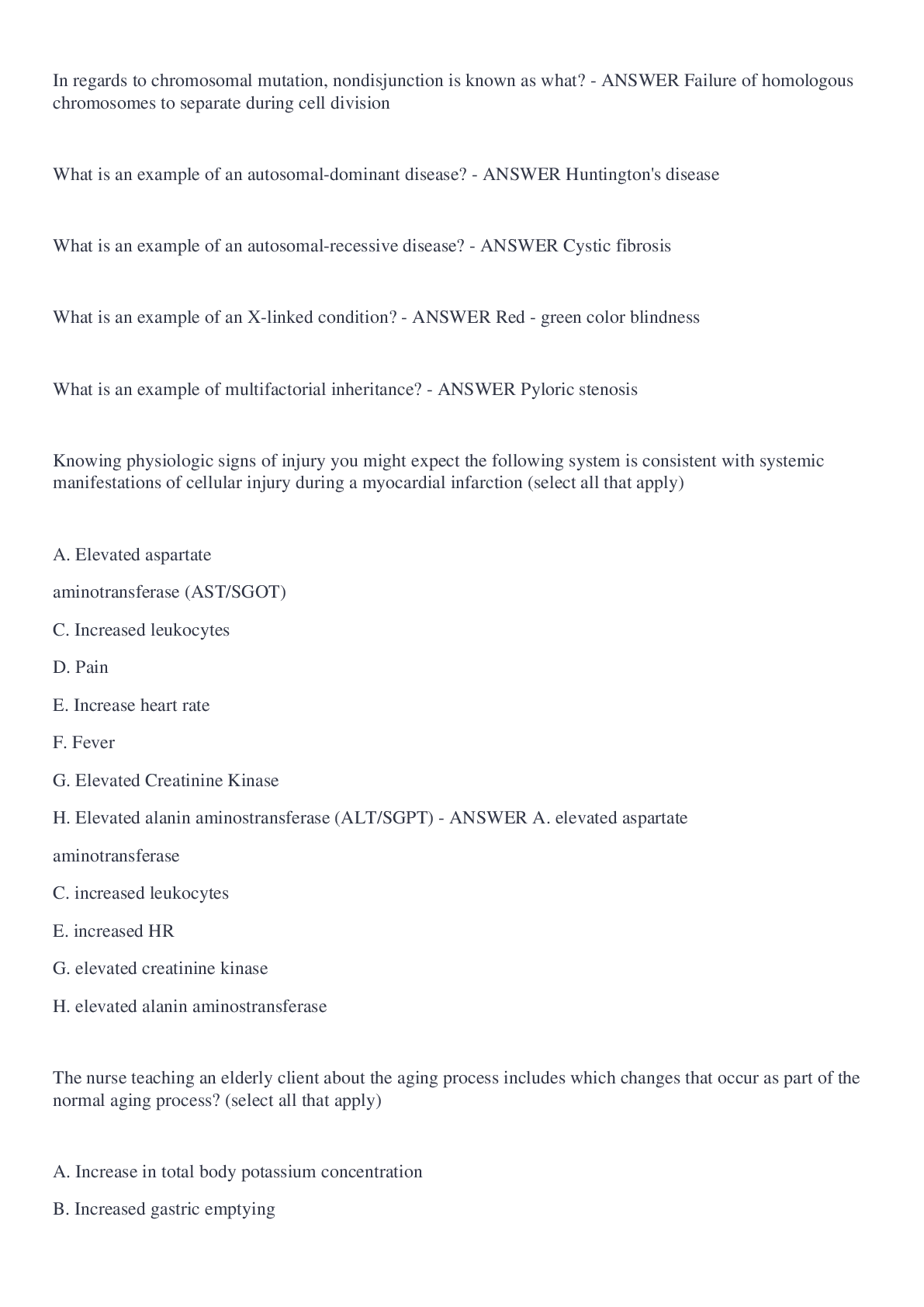
Buy this document to get the full access instantly
Instant Download Access after purchase
Add to cartInstant download
Reviews( 0 )
Document information
Connected school, study & course
About the document
Uploaded On
Jul 02, 2022
Number of pages
16
Written in
Additional information
This document has been written for:
Uploaded
Jul 02, 2022
Downloads
0
Views
34

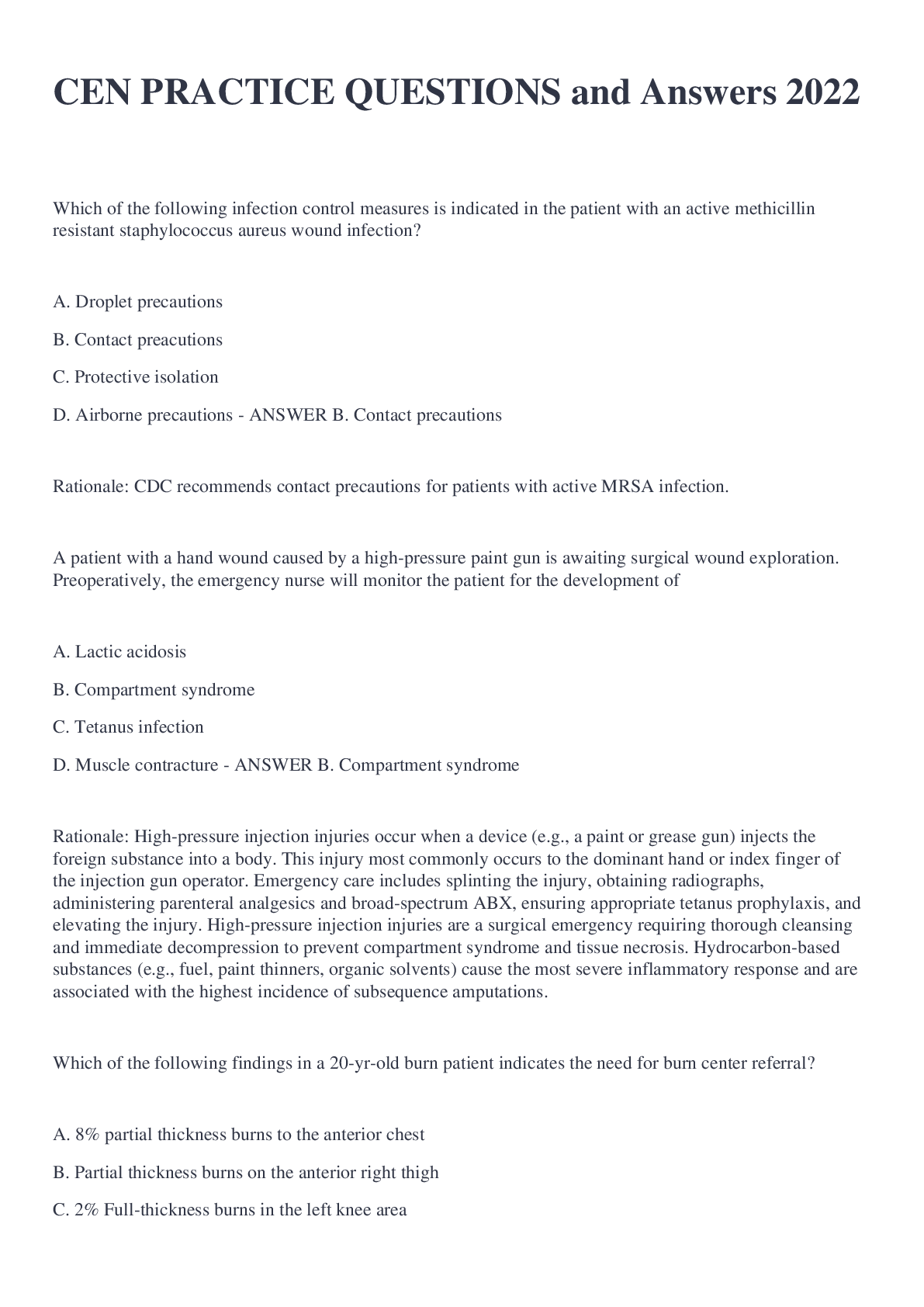


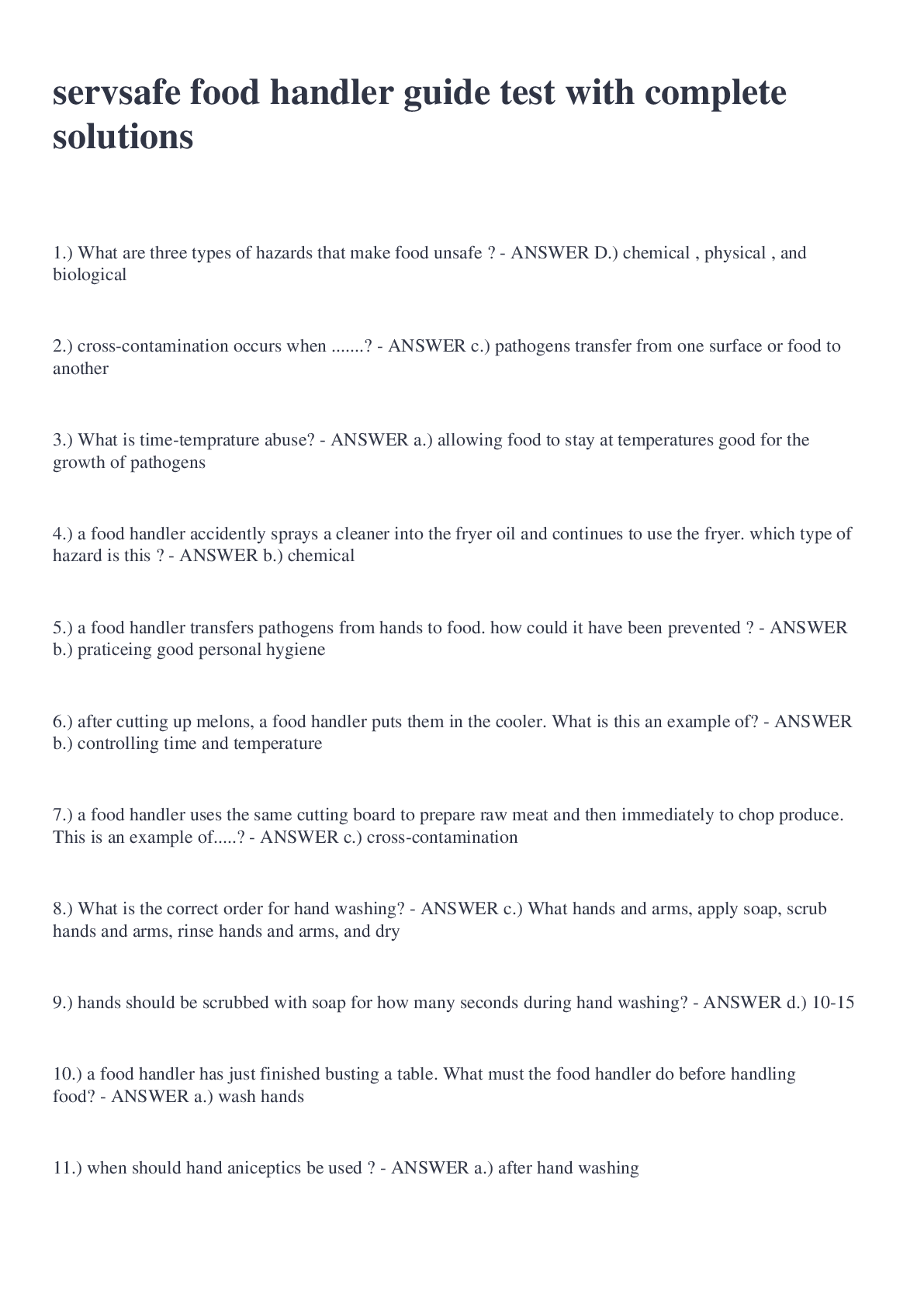


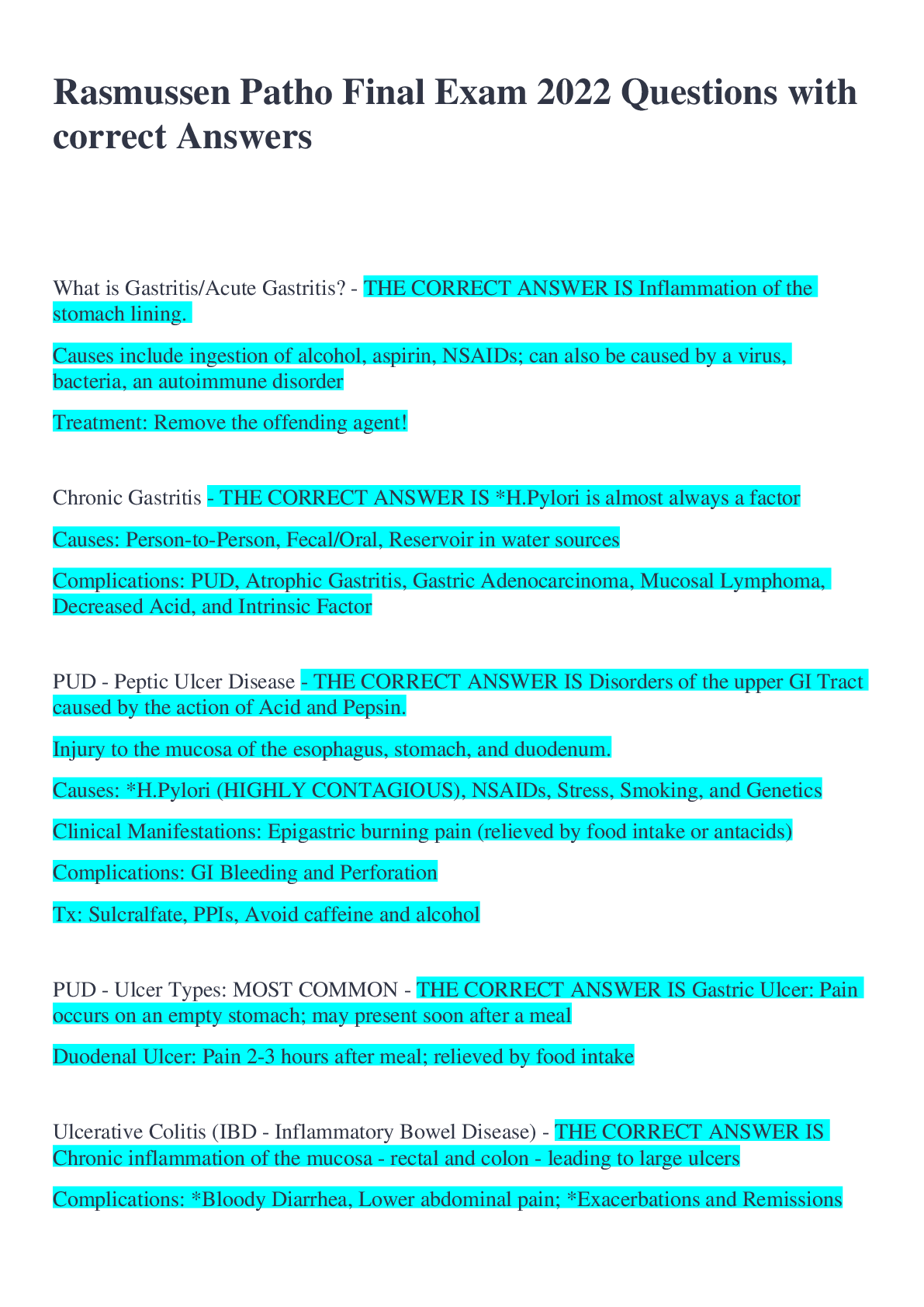
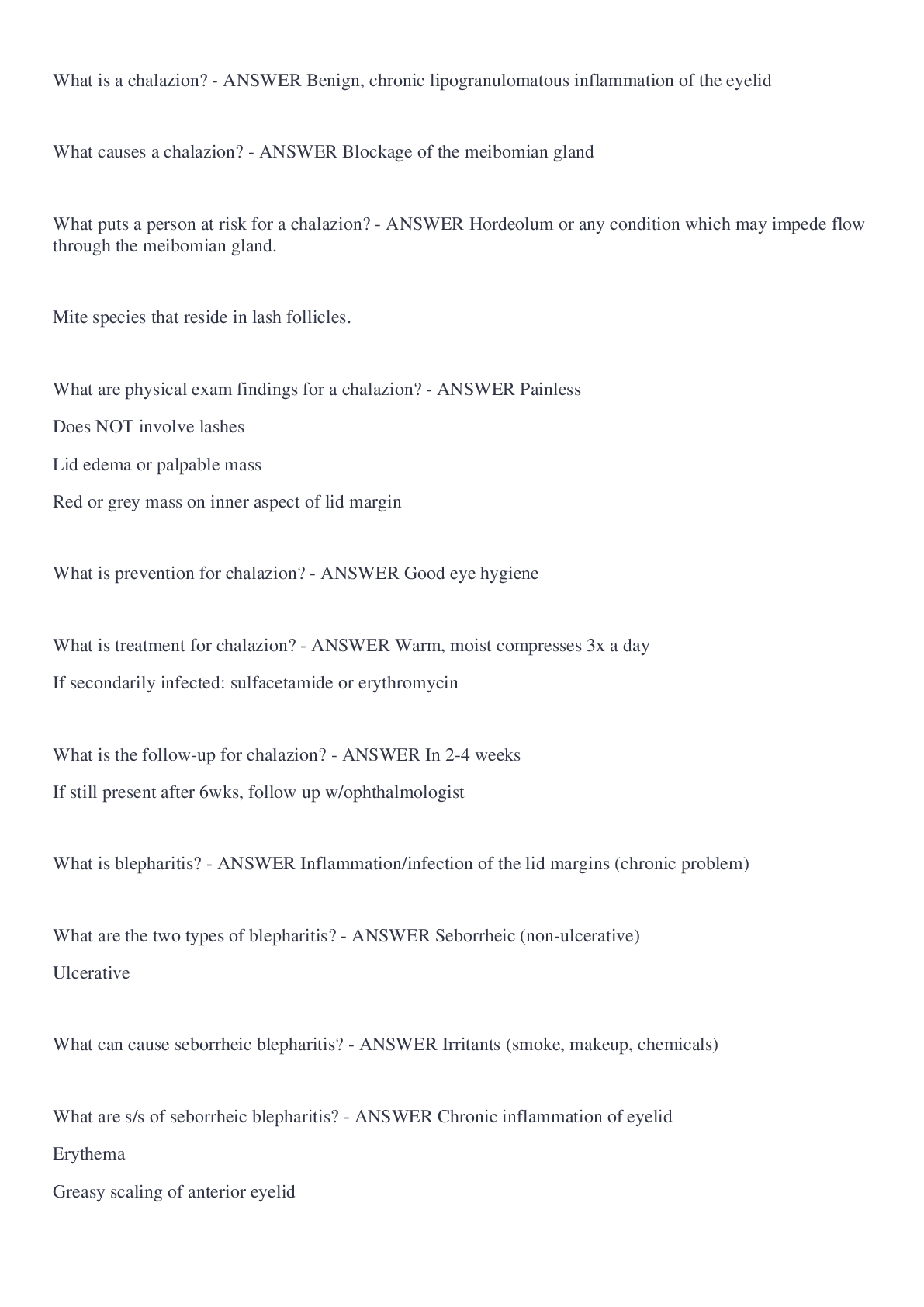
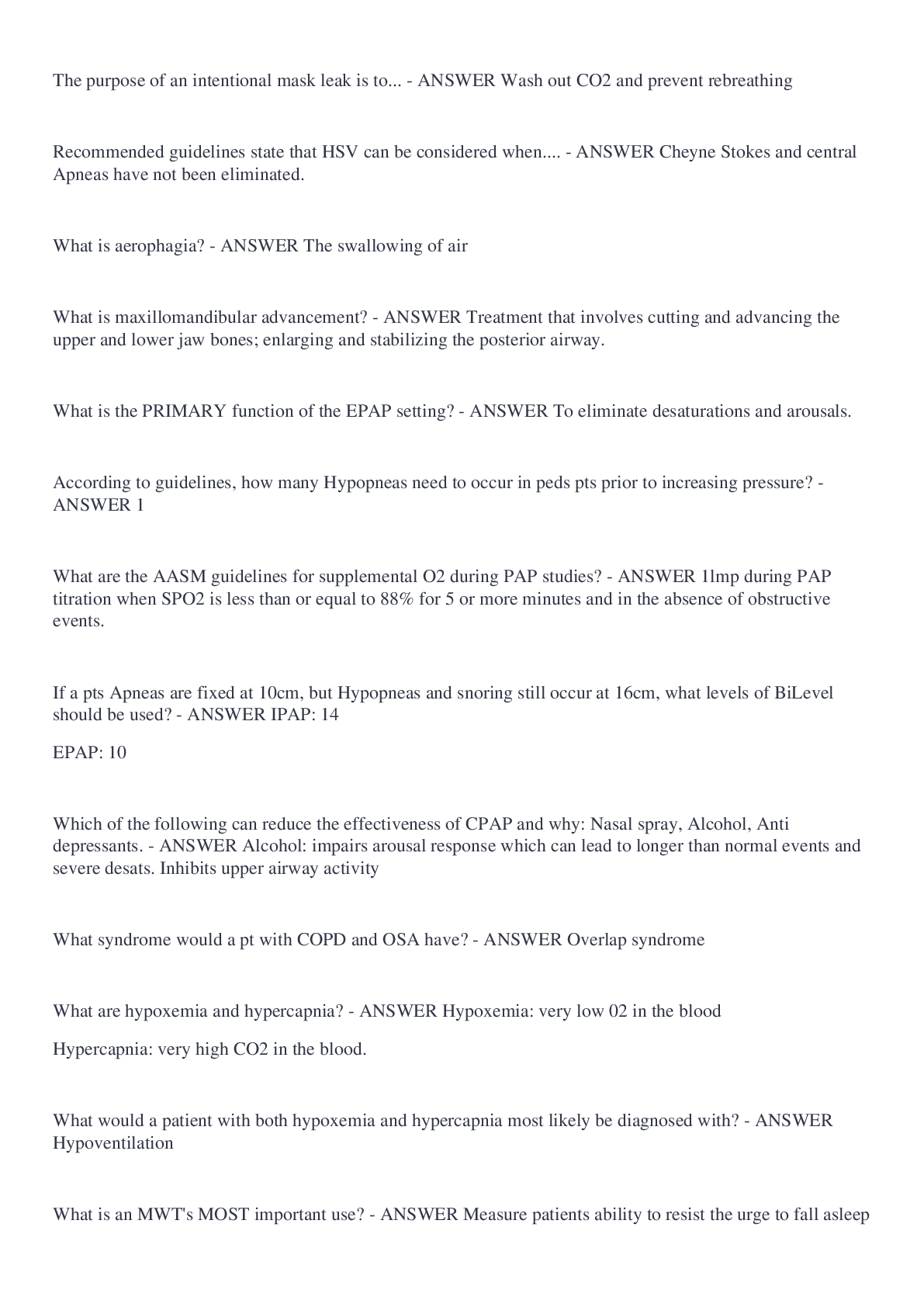




.png)
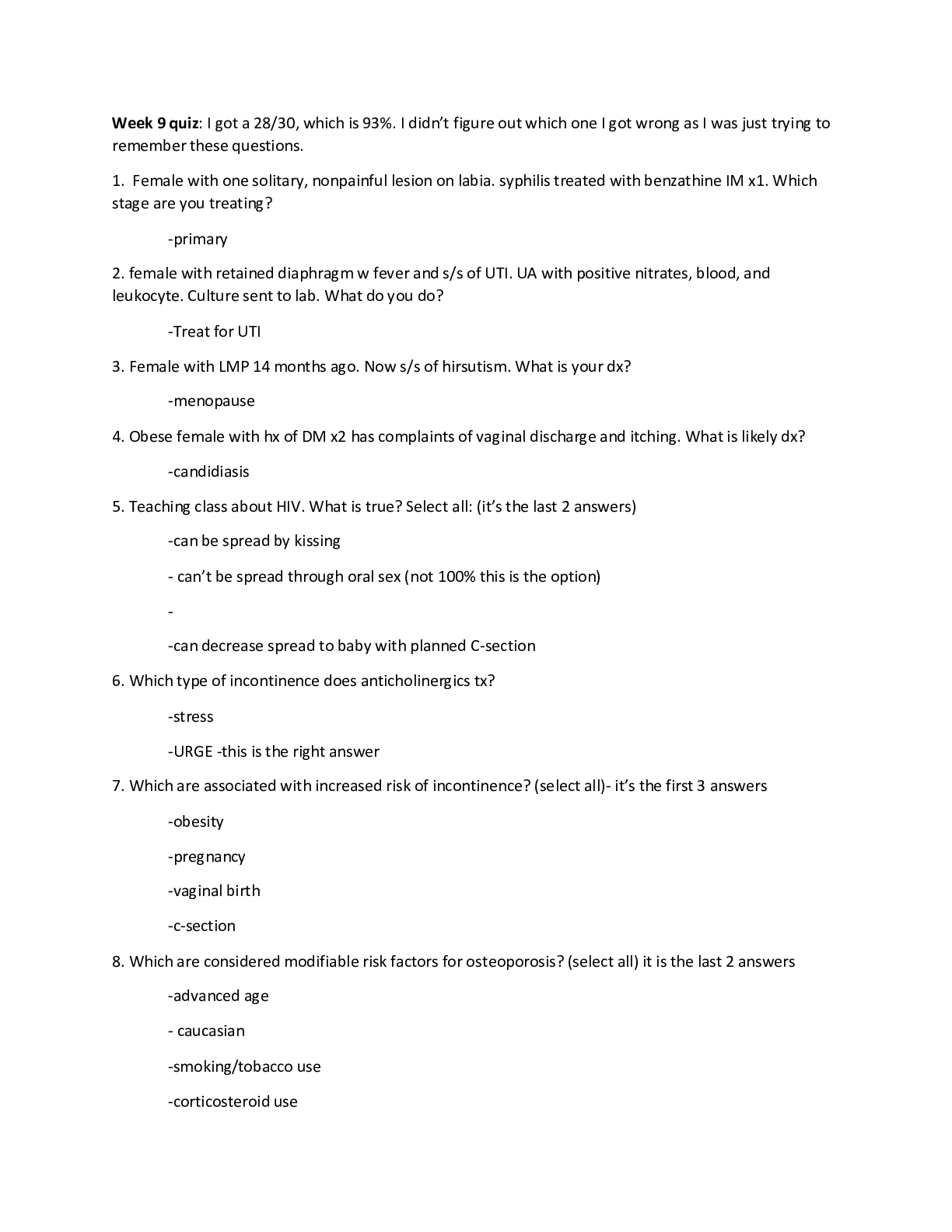
.png)
.png)
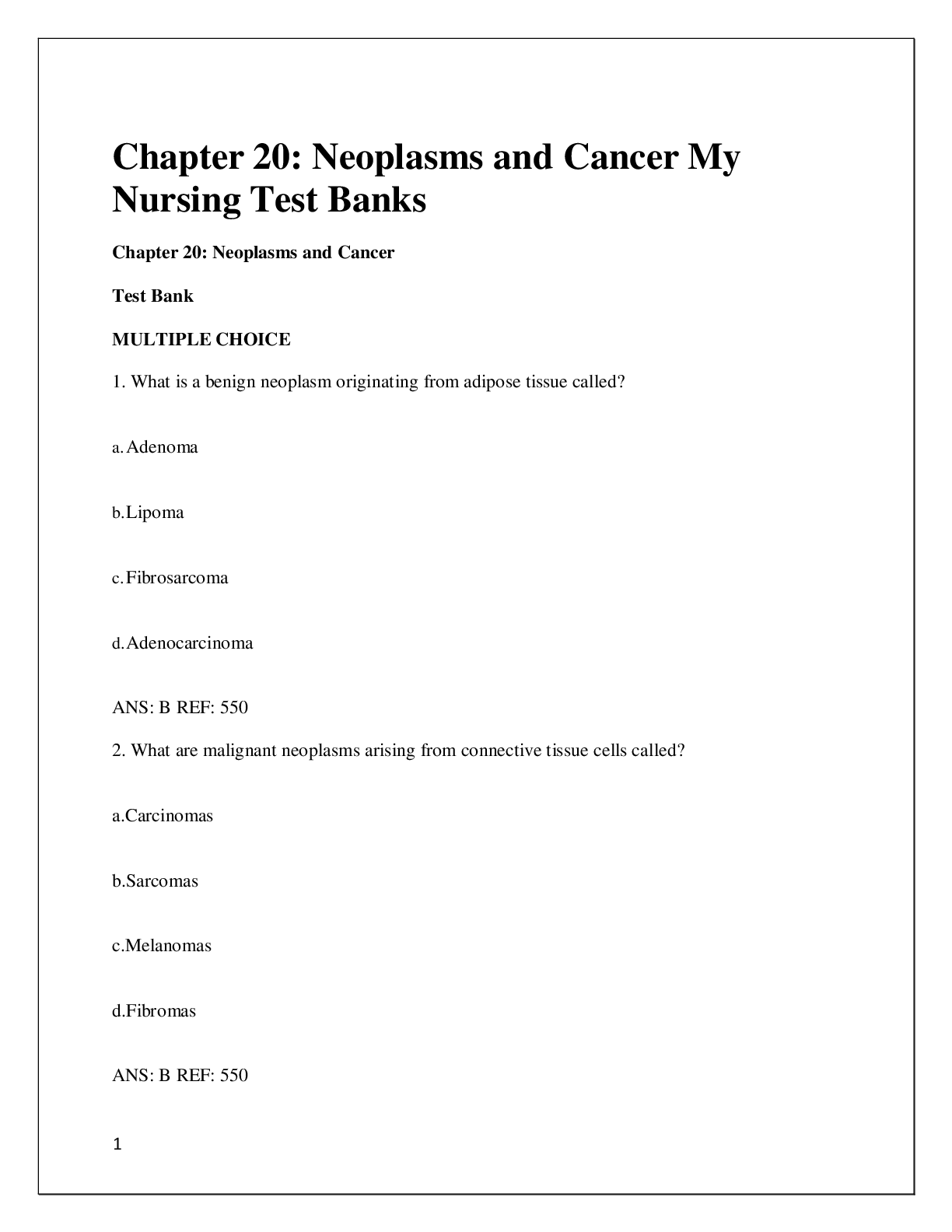
.png)
.png)
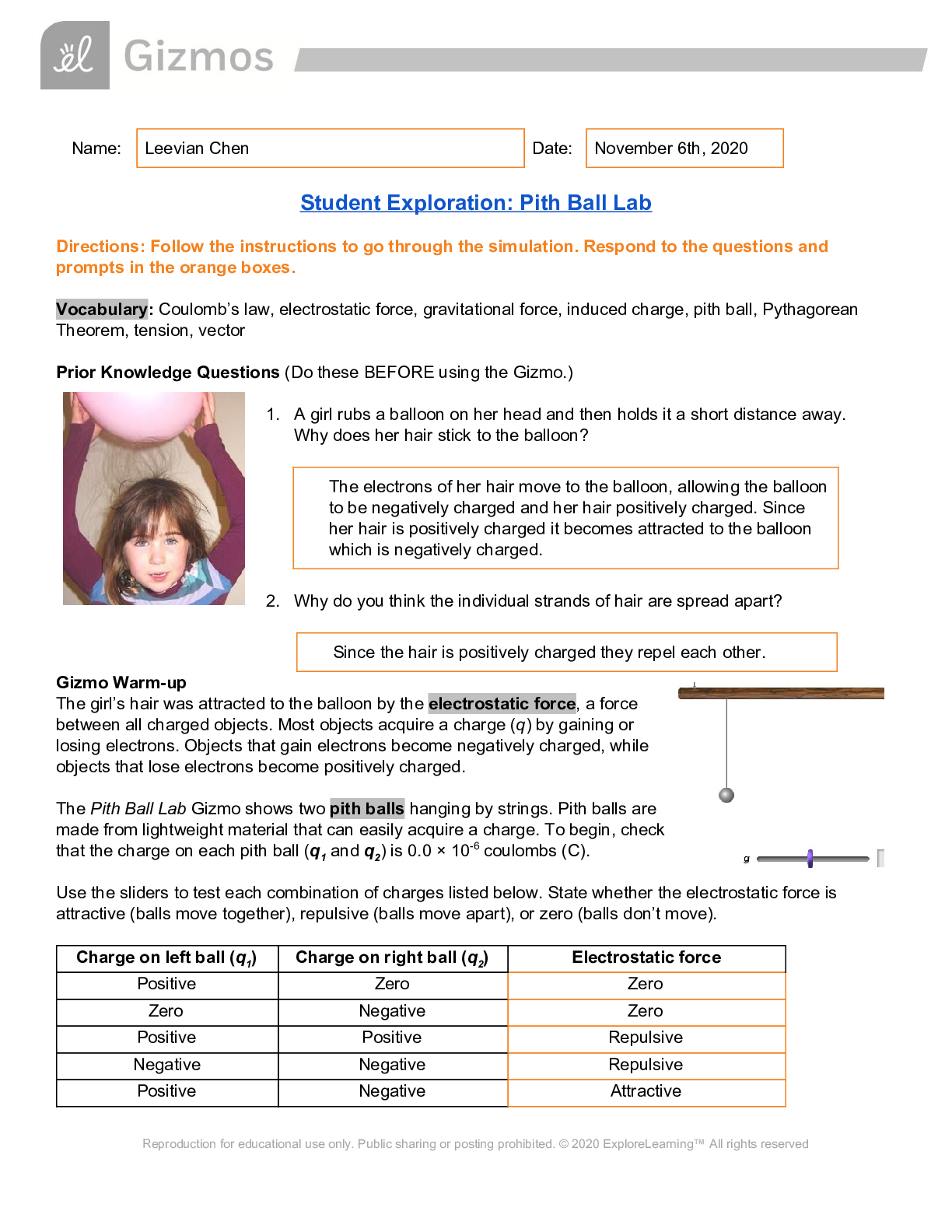
.png)
.png)

